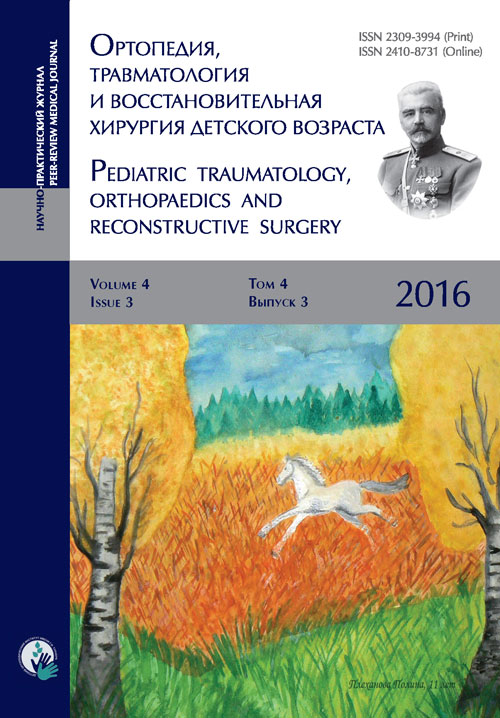Мобильность пяточно-ладьевидного сегмента в клинической диагностике пяточно-ладьевидных коалиций
- Авторы: Сапоговский А.В.1
-
Учреждения:
- ФГБУ «НИДОИ им. Г.И. Турнера» Минздрава России
- Выпуск: Том 4, № 3 (2016)
- Страницы: 59-62
- Раздел: Статьи
- Статья получена: 05.10.2016
- Статья опубликована: 15.09.2016
- URL: https://journals.eco-vector.com/turner/article/view/3657
- DOI: https://doi.org/10.17816/PTORS4359-62
- ID: 3657
Цитировать
Аннотация
Введение. Тарзальные коалиции — порок развития костей стопы, характеризующийся костным, фиброзным или хрящевым сращением между несколькими костями предплюсны. Наиболее выраженной клинической особенностью у пациентов является ограничение мобильности суставов предплюсны. Оценка мобильности стопы производится на основании клинических тестов «вставания на цыпочки», Jack, мануальной оценки пассивной инверзии / эверзии стопы. Указанные тесты не обладают высокими значениями чувствительности и специфичности и не позволяют осуществлять дифференциальную диагностику между различными видами коалиций.
Цель исследования: улучшение клинической диагностики пяточно-ладьевидных коалиций.
Материалы и методы. Предложен новый клинический тест для определения мобильности пяточно-ладьевидного сегмента. Оценка его диагностической значимости выполнена на основании результатов исследования 100 пациентов (155 стоп), из них: 22 пациента / 30 стоп с таранно-пяточными коалициями, 28 пациентов / 45 стоп — с пяточно-ладьевидными коалициями, без тарзальных коалиций — 50 пациентов / 80 стоп.
Результаты. Чувствительность данного теста составила 95,6 %, а специфичность — 93,3 %. Данный тест обладает хорошей воспроизводимостью, о чем свидетельствует значение коэффициента межэкспертной надежности — 0,818.
Заключение: оценка мобильности пяточно-ладьевидного сегмента позволяет идентифицировать пациентов с пяточно-ладьевидными коалициями при отрицательных значениях других клинических тестов мобильности стопы.
Ключевые слова
Полный текст
Об авторах
Андрей Викторович Сапоговский
ФГБУ «НИДОИ им. Г.И. Турнера» Минздрава России
Автор, ответственный за переписку.
Email: sapogovskiy@gmail.com
канд. мед. наук, научный сотрудник отделения патологии стопы, нейроортопедии и системных заболеваний ФГБУ «НИДОИ им. Г.И. Турнера» Минздрава России.
Список литературы
- Кенис В.М. Тарзальные коалиции у детей: опыт диагностики и лечения // Травматология и ортопедия России. - 2011. - № 2 (60). - С. 132-136. [Kenis VM. Tarsal coalitions in children: diagnostics and treatment.Travmatologia i ortopedia Rossii. 2011;2(60):132-136. (In Russ).].
- Кенис В.М., Никитина Н.В. Тарзальные коалиции у детей (обзор литературы) // Травматология и ортопедия России. - 2010. - № 3. - С. 159-165. [Kenis VM., Nikitina NV. Tarsal coalitions in children (Review).Travmatologia i ortopedia Rossii. 2010;3:159-165. (In Russ).]
- Blakemore LC, Cooperman DR, Thompson GH. The rigid flatfoot: tarsal coalitions. Clin Podiatr Med Surg. 2000;17(3):531-555.
- Kendrick JI. Tarsal coalitions. Clin Orthop. 1972;85:62-63. doi: 10.1097/00003086-197206000-00013.
- Perman MD, Wertheimer SI. Tarsal coalitions. J Foot Surg. 1986;4:25-41.
- Кенис В.М., Сапоговский А.В. Клиническая диагностика ригидных форм плано-вальгусных деформаций стоп у детей // Травматология и ортопедия России. - 2015. - № 4 (78). - С. 46-51. [Kenis VM, Sapogovskiy AV. Clinical diagnosis of rigid flatfoot in children. Travmatologia i ortopedia Rossii. 2015;4(78):46-51. (In Russ).]
Дополнительные файлы









